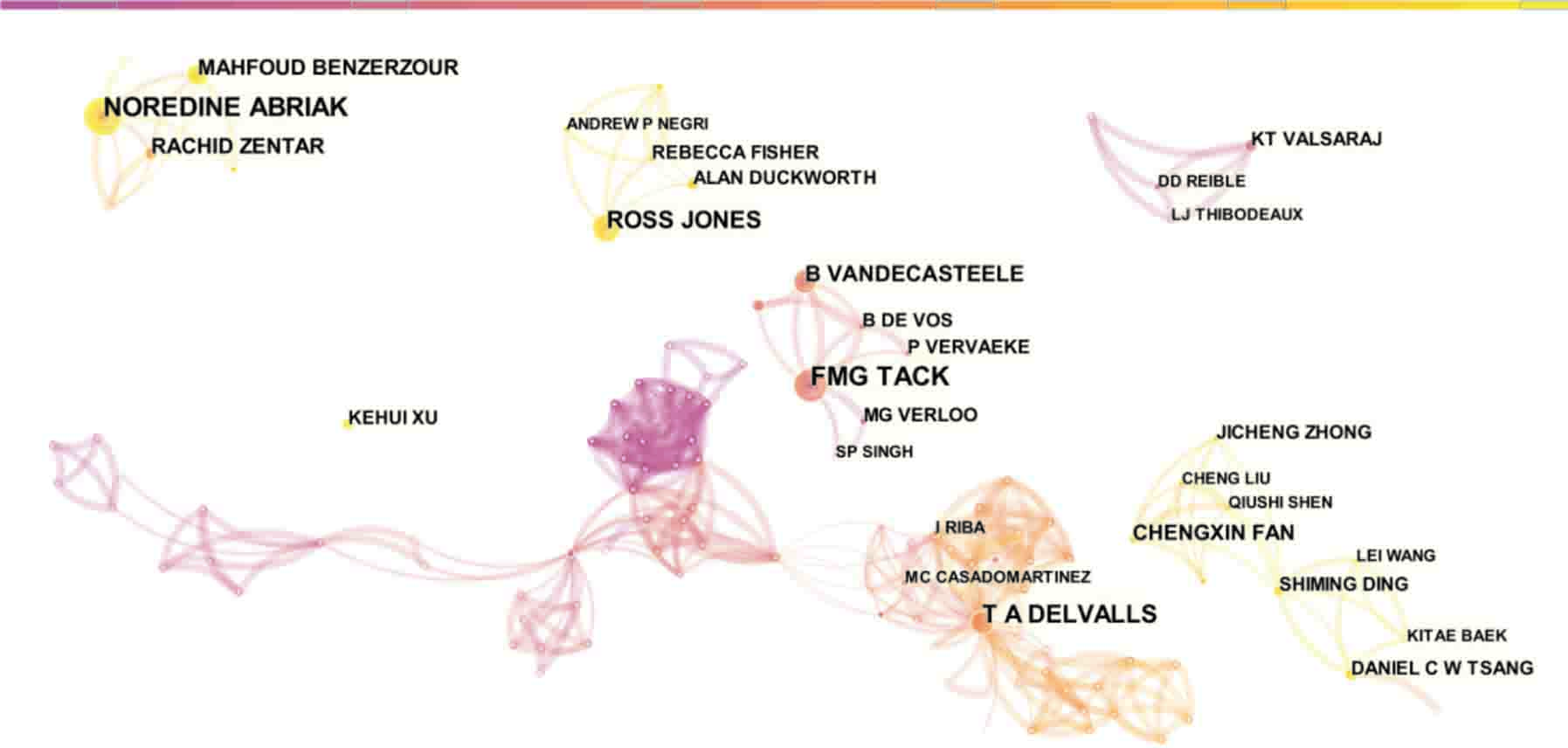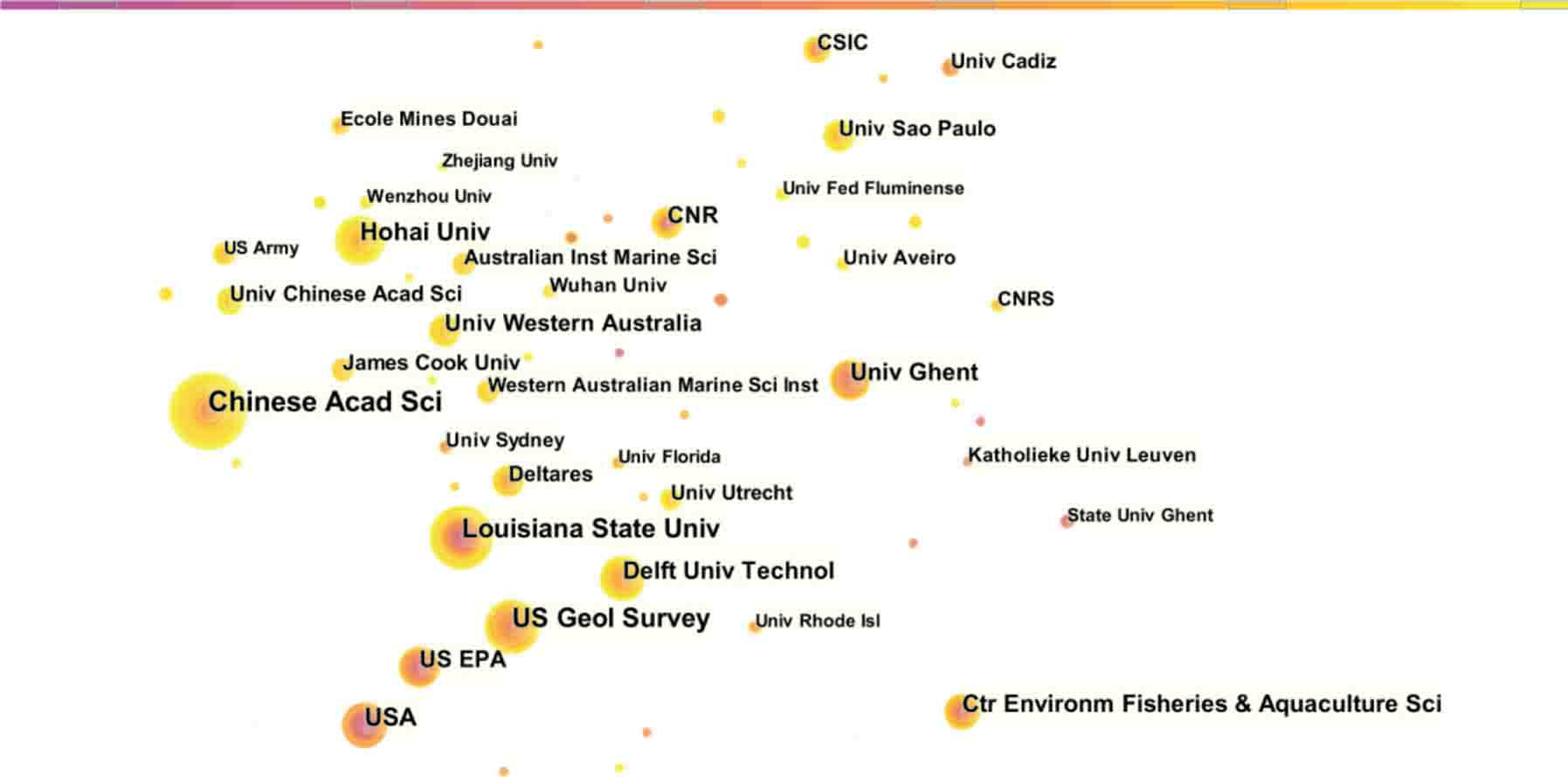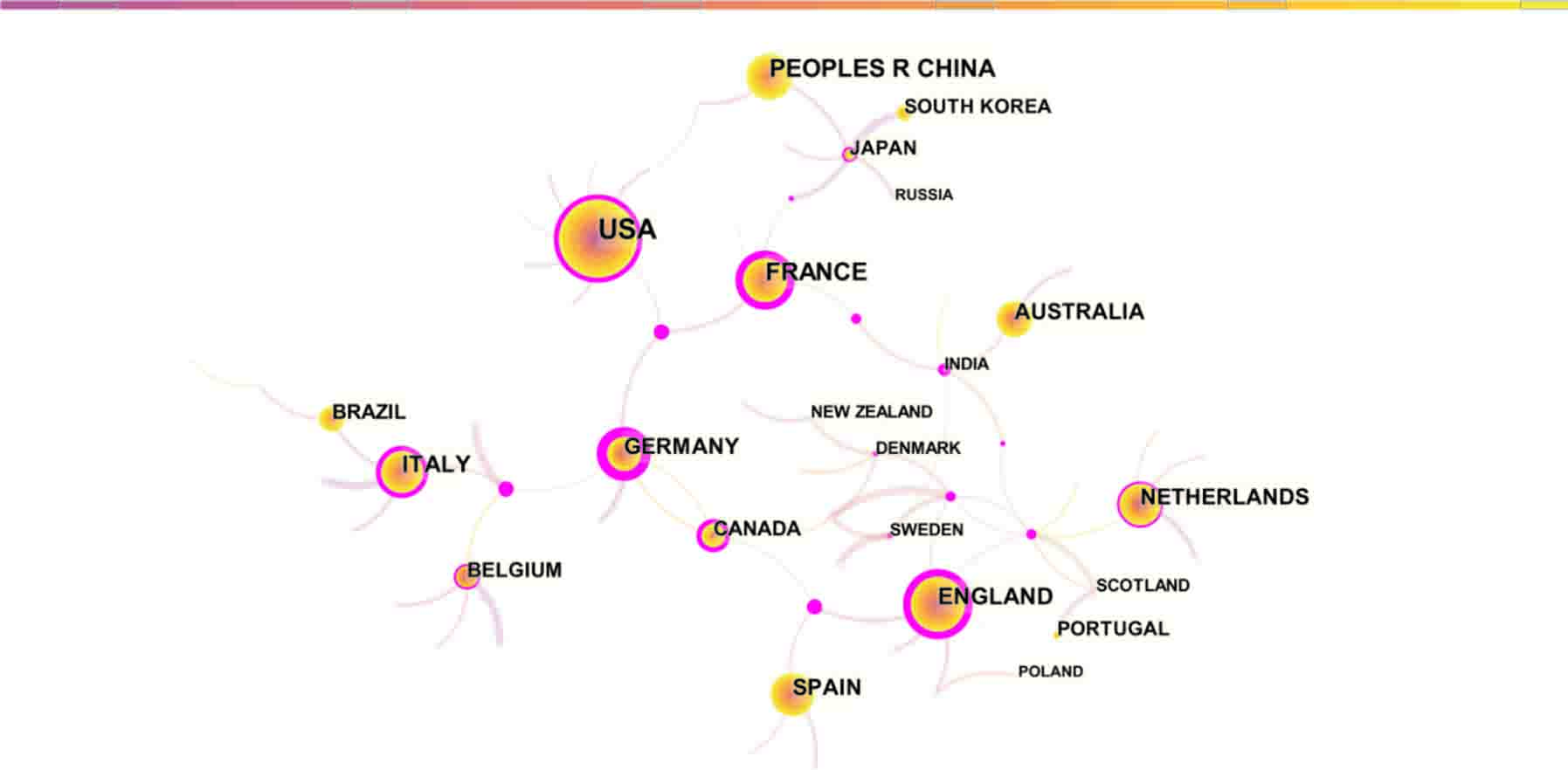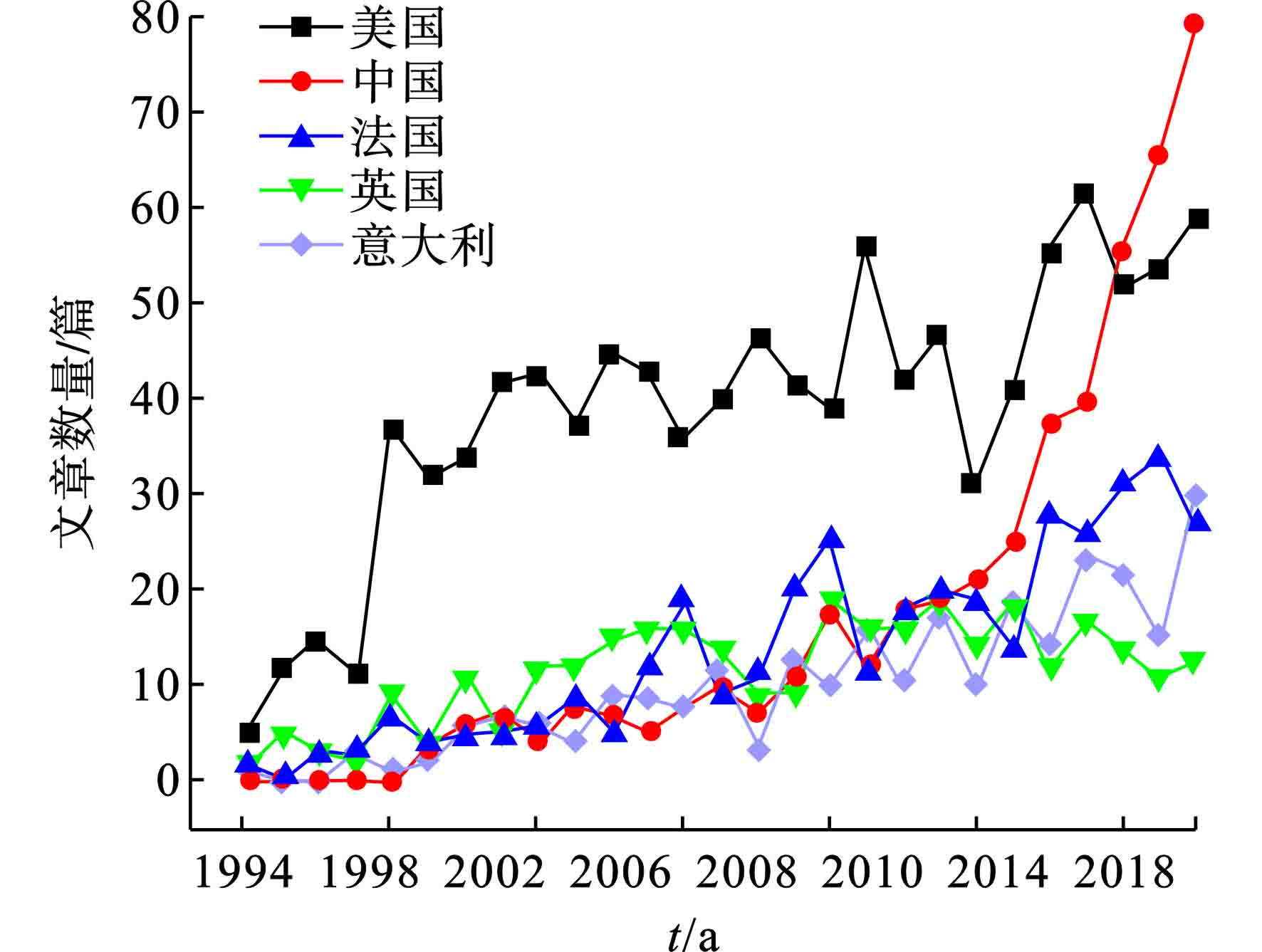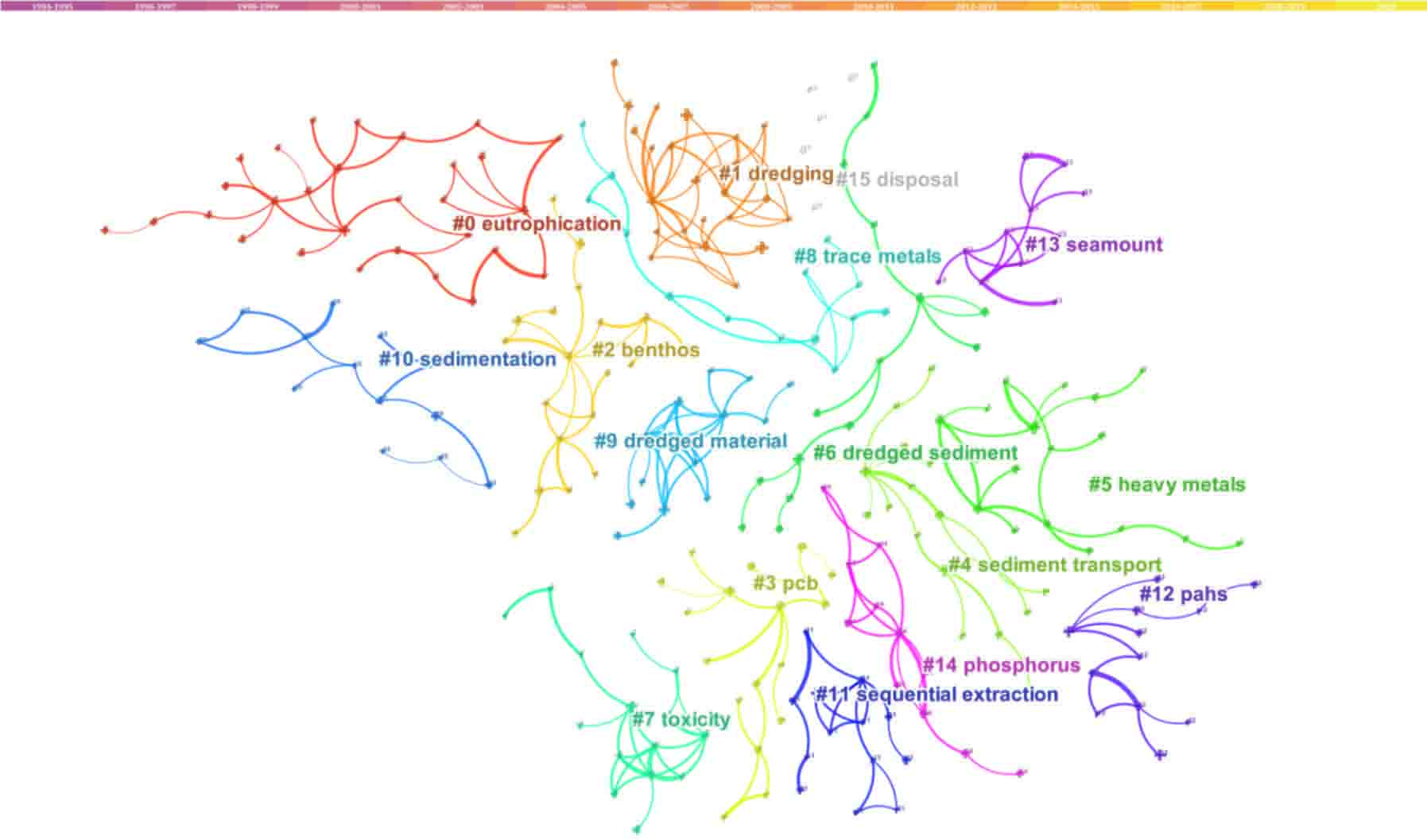-
底泥是黏土、泥沙、有机质和各种矿物的混合物,经长时间物理、化学和生物等作用及水体传输而沉积于水体底部所形成[1]。污染物汇聚到水体中,底泥能够吸附水体中的大部分污染物,主要包括营养物质(氮、磷和钾等)、有毒重金属和难降解有机污染物。当水体的动力、化学等条件发生变化时,附着在底泥上的污染物会发生脱落,再次进入水体中,造成二次污染[2],间接对底栖生物或上覆水生物产生毒害作用,甚至通过生物富集过程进入食物链影响人体健康[3]。因此底泥是一个潜在而又巨大的内污染源,是水体整治的关键环节之一。目前,底泥的疏浚已被广泛应用于世界各地的水体环境治理工程中[4],也因此产生了大量具有环境风险的疏浚底泥。
CiteSpace作为一款可视化分析工具,可以分析某一科研领域研究内容的热点和研究趋势的演替过程,了解该领域内科研成果突出的作者、机构,深入发掘微观层面和宏观层面之间的内在联系[5]。本研究旨在利用CiteSpace软件分析疏浚底泥在全球范围内相关研究,揭示近30年来国际上对其的关注热点以及研究动态,为科研工作者们了解疏浚底泥研究领域发展的总体情况、拟定相关研究目标与发现提供依据。
-
ISI Web of Science 是全球最大、覆盖学科最多的综合性学术信息资源,国际上进行科学统计与评价主要利用其相关的引文数据库。本文的文献数据摘自Web of Science核心合集。检索式为:TS=((dredged sediment*) OR (dredged mud*) OR (dredged silt*) OR (dredged sludge)) NOT TS=((activated sludge*) AND (sewage sludge*)),限定语种仅为English,文献类型为Article和Review,检索年限范围为1994~2020年,共获得4 213篇文献信息。利用CiteSpace软件对其进行可视化分析处理,基于文献相关信息(包括关键词、作者、作者对应机构和国家)和不同年份文献相关信息出现的频次等来构建疏浚底泥研究的发展和网络图谱。
-
对文献产出按Article和Review统计分析,见图1。
图1可知,Article数量呈现上升趋势且增幅很快,2020年高达301篇,反映了全球范围内对疏浚底泥具体研究的重视程度不断加大。Review数量相对较少,但发文数量总体也呈上升态势,2020年有16篇综述文章,也反映出对疏浚底泥研究的不断归纳、逐步完善的过程。
-
CiteSpace的科研合作网络分析提供了从微观到宏观3个层次的合作类型分析,分别为作者、机构和国家的合作网络分析,通过CiteSpace对上述4 213篇文献进行分析,可得到全球范围内对疏浚底泥研究在地域上的分布情况。
-
发文量位居前20名的作者及其相关信息,见表1。
发文量排名靠前的作者合作网络关系图,见图2。其中每个节点对应不同的作者,节点大小表示作者发文的多少,节点的颜色表示作者发文年代的先后,而节点之间的连线表示两个不同的作者有着合作的关系,连线的粗细表示合作次数的多少,连线的颜色表示合作时间的先后。
图2可知,图中具有多个合作子网络。早期从1996年始,比利时根特大学的TACK研究团队调研了不同地区的疏浚底泥的重金属污染特征[6],并且研究了通过植物修复技术对疏浚底泥进行处置,发现种植过程中底泥重金属均有向植株中转移的现象,而有机污染物如多环芳烃发生降解[7-8]。从2003年始,以CASADO-MARTINEZ et al[9]和DELVALLS et al[10]为核心的西班牙加的斯大学研究团体,其团体内合作较为密切,且合作网络广。他们对西班牙不同地区河流底泥的污染情况进行了评估,并编写沉积物质量指南、修订了用于评估底泥质量的测试及处置管理的相关指南,为日后管理提供指导。近年来,澳大利亚海洋科学研究所JONES研究团队研究了底泥疏浚过程产生的悬浮泥沙对珊瑚礁水质的影响,以及对海水质量在时间和空间上的影响[11],并建立了相应的模型[12],拟定了疏浚区域的水质阈值以及讨论了多种因子对阈值的影响[13]。法国里尔-杜埃国立高等矿业电信大学ABRIAK研究团队研究了海洋疏浚底泥作为道路建材的潜力,通过添加粘合剂如水泥或石灰以增加底泥的机械强度,经相关力学试验测定发现处理后的底泥满足用作道路施工中的相关标准,其作为道路路基材料是可行的[14-15]。
中国也有中国科学院南京地理与湖泊研究所的范成新研究团队、香港理工大学土木与环境工程系的TSANG研究团队,他们的研究偏向底泥的资源化利用,如通过向底泥中添加木质废物并制得生物质炭,以强化对底泥中有机污染物和有毒物质的稳定化作用,并生产环保型建筑材料,如路基填料和路砖,实现了底泥资源化[16];又如利用富钙/低钙工业副产物来实现了对底泥中污染物的固定并制作路砖,从而开发出了一种新的疏浚底泥绿色处置技术[17]。总的来说,不同作者及其团体的研究侧重点不同,早期的研究侧重于底泥的风险评估和稳定化,后期则侧重于资源化利用。
-
发文量排前10的机构:中国科学院(124篇)、路易斯安那州立大学(71篇)、美国地质调查局(60篇)、河海大学(55篇)、美国陆军(52篇)、代尔夫特理工大学(47篇)、根特大学(46篇)、英国环境、渔业和水产养殖科学中心(42篇)、意大利国家委员会(38篇)和西澳大学(37篇)。机构合作网络分析的可视化,见图3。
发文量靠前的机构集中在中国、美国和欧洲部分国家,而图中各节点颜色偏向蓝紫色的为研究年份较早的节点,这些节点的数量少于节点呈黄色的数量,说明全球范围内疏浚底泥的研究仍然处于较为热门状态。中国科学院发文时间多集中在近几年,在该领域内的研究越来越多;路易斯安那州立大学则是从早期到近几年均有发文,说明该机构一直在开展相关研究;而美国陆军、根特大学等机构的研究则集中在较早年份,说明目前他们研究力度已有所下降。
-
全球范围内发文量排名前10的国家:美国(1 063篇)、中国(470篇)、法国(373篇)、英格兰(313篇)、意大利(272篇)、澳大利亚(243篇)、荷兰(228篇)、西班牙(205篇)、德国(189篇)和加拿大(174篇)。各国合作网络可视化结果,见图4。
从各节点之间的连线上来看,各国之间的合作多呈现出以洲为范围的合作,欧洲国家如英格兰、荷兰、葡萄牙和西班牙之间的合作,亚洲国家如中国、日本、印度和韩国之间的合作,这可能与疏浚底泥的地域性有关。其中,发文量排名前5名国家的每年发文量,见图5。
美国、法国和意大利发文量总体呈较为平缓的上升趋势。我国底泥研究起步于1999年,晚于其他4国,总体发文数量落后美国居第二,但整体上升趋势迅速,特别是2015年以后,2019和2020年的发文量均已超过美国,2020年更是高达80篇。随着国内对疏浚底泥领域不断深入、系统地研究,我国在该领域内的国际影响力也将不断扩大。
-
关键词能够反映文章的内容与主题,是对文章高度精炼的概括,也是进行文献主题及领域发展分析时可信度高的指标。关键词的共现分析是对数据集的作者提供的关键词进行共词分析。共词分析是对一组词(往往提取关键词)两两统计它们在同一组文献中出现的次数,通过这种共现次数不仅能测度他们之间的亲疏关系,也能反映各自出现的频次[18]。前者反映出所选取的文献集的各关键词之间的关系,关系相对紧密的关键词具有较强的联系,可进行归纳总结,得出相应主题,即聚类;后者可以通过出现次数从一定程度上反映出该领域的研究动向和热点。因此,通过共词分析对所研究领域进行包括学科的热点内容、主题分布以及学科结构等问题的探讨。
-
对所提取的文献进行关键词分析,得到各关键词的复现频次,其中排名前20的关键词,见表2。除了主题检索词或与主题检索词相似的词(如sediment、dredging等)外,其他关键词如污染、重金属、多环芳烃、修复和沉积物运送等都成为复现频次高的关键词,近20年排名均未跌出前15名,是历来研究的热点。
-
根据关键词联系的强度进行总结,得到关键词聚类图,见图6。其中,不同聚类用不同颜色显示,聚类标签中的顺序数字越小的,表示聚类中包含的关键词越多,但与关键词的复现频次并无直接的关系。每个聚类是关系紧密的关键词所组成的,总结得到:富营养化、底泥疏浚工程、底栖生物、多氯联苯、底泥转移运输、重金属、疏浚底泥和毒性等16个聚类,其中各聚类中含有关键词的数量以及复现频次排名前20的关键词的数量,见表3。
复现频次排名前20的关键词基本平均分布在每个聚类中,从聚类的标签来看,对于底泥的研究热点集中在对底泥理化性质的研究、底泥的处置以及与底泥有联系的环境和生物群落,其中,对底泥的理化性质研究较多。
-
综合出现频次较高的热门关键词以及聚类统计结果,研究热点主要集中在以下几个方面。
-
底泥污染,即自然或人为的破坏,向底泥中添加某种物质而超过环境的自我净化能力而产生危害的行为。具体而言,自然与人为的破坏因素主要包括[19]:大气沉降、侵蚀、城市污染物排放、农业物料的使用、采矿以及焚烧和工业排放。CHAPMAN et al[20]认为,毒性是危害的度量,通过毒性测试以了解底泥污染的性质以及危害程度,并利用它进行生态风险评估、指导疏浚底泥的管理与决策。文献[21]通过测定底泥中各种污染物质的含量,进行污染物的分布以及生态风险评估,并得到了底泥中污染物的来源,其中部分污染物质主要(如Cu、Hg等)为人为因素输入,而Fe、Zn等则来源于沉积岩的风化作用。
-
重金属(Heavy Metal)难以被生物降解,且具有生物富集效应。疏浚底泥中含有多种重金属,因此底泥中的重金属以及修复一直都受到研究者的关注。MULLIGAN et al[22]归纳了一系列针对疏浚底泥中重金属的评估和处置方法,如连续萃取、玻璃化、热处理和生物处理等。MEERS et al[23-24]研究了利用植物从疏浚底泥中吸取重金属,并向底泥中加入土壤改良剂如EDTA等物质,发现一定量的重金属已转移到植物体中。KIM et al[25]探讨了电动萃取法从海洋疏浚底泥种萃取重金属的适用性,发现HCl对重金属的萃取效果优于HNO3,这是由于氯离子更能与金属离子形成沉淀或者络合物,促进了底泥颗粒表面的解吸作用,提升了重金属的萃取效果。
-
底泥中的有机物往往包括一些致癌性很强的持久性有机污染物(POPs),如多环芳烃(PAHs)、多氯联苯(PCBs)。PERELO[26]综述了有机污染的种类、来源及其在底泥中的转移和转化过程。LOWRY et al[27]采用纳米零价铁以及KRUMINS et al[28]通过微生物对底泥中多氯联苯(PCBs)进行原位脱氯,COLACICCO et al[29]与AMMAMI et al[30]采用强化电动工艺降解多环芳烃(PAHs),DONI et al[31]研究了植物修复技术对底泥总石油烃(TPH)的去除效果。
-
农业、工业等活动排放的氮和磷含量较高,大量营养盐输入水体中,造成水体富营养化。营养盐的修复往往需要对内外环境的治理同时进行。LARDICCI et al[32]提到,为解决地中海西部最大的湖泊之一奥贝蒂洛湖严重的富营养化问题,采取了包括打捞海藻、排空湖内所有废水、进行底泥疏浚和扩大航道等措施。OENEMA et al[33]建议,为改善地表水的富营养化状况,应将减少农业中氮、磷的排放与疏浚底泥、冲洗沟渠以及减少其他营养盐来源等多种手段结合。HICKEY et al[34]认为,要减轻富营养化,需采取综合办法,减少内外部的营养负荷。其中,内部营养负荷是产磷的主因,可通过疏浚、曝气等方法减少底泥中的磷释放到水体中。
-
底泥的资源化利用一方面能解决底泥的处置问题,另一方面充分利用了底泥的自然资源的属性,并产生经济价值。底泥的资源化在探索和实践中不断多样化,常见的包括土地、建筑和能源利用。
底泥中往往富含一定的有机质、营养元素,将底泥进行土地利用,可为植物、作物提供生长所需的多种元素,并改善栽培基质的理化性质。MATTEI et al[35]将疏浚底泥和园林废物进行共堆肥,堆肥产品可用作栽培基质,实现了底泥的资源化利用。BRAGA et al[36]利用水库中的富营养底泥对玉米进行栽培,相较于传统施肥,利用底泥中的营养元素作为作物氮素来源可节省约25%的经济成本。
底泥是一种沉积物,含有丰富的矿物元素,可进行建筑利用。WANG et al[37]利用疏浚底泥与硅改性氧化镁水泥制得具有良好力学性能与污染物固化效果的建筑填充材料。MITAOUI et al[38]利用疏浚底泥与钢渣按照不同配比混合制的道路材料,根据混合料的堆积密度确定最佳配比。研究表明,该材料具有一定稳定性,符合标准,可用于道路施工。此外,国内也有利用底泥进行制备陶粒的例子[39],制备的陶粒具有保温性能,可用于建筑材料。
由于底泥自身的性质,还可用于能源利用。底泥中含有大量微生物,构筑微生物燃料电池不仅可以对底泥中的有机物进行降解,还能回收电能[40]。BARDAROV et al[41]利用保加利亚布拉格弗格斯附近收集的底泥制备沉积物微生物燃料电池,具有一定的产电性能、效率和稳定性,可为低功耗用户供电。ZHU et al[42]构建了湿地植物-底泥-微生物燃料电池系统(PSMFC)和湿地-底泥-微生物燃料电池系统(SMFC),研究了它们的发电性能以及底泥和上覆水中重金属的转化。结果表明,在电池系统产电时,底泥中重金属的生物有效性降低,并减少了这些金属向上覆水的迁移。
-
通过CiteSpace可视化研究工具对1994~2020年全球范围内疏浚底泥领域内的文献进行了分析,介绍了该领域内较为核心的研究者以及机构,总结了疏浚底泥的研究热点以及研究趋势。底泥作为潜在的内污染源,在愈发重视环境友好型发展的国际大背景下,其研究热度也愈来愈高。底泥的最终处置愈来愈多元化,从较早期的稳定化(如针对单一污染物的脱除、植物修复技术和电动等)到近年来较为热门的资源化利用(如底泥制砖、路基材料、栽培基质等),这也体现了废物再利用的可持续发展精神,实现底泥乃至更广范围的废弃物的资源化利用,将是相关领域持续的研究方向。
基于CiteSpace的疏浚底泥全球研究态势可视化分析
Visual analysis of global research on dredged sediment based on CiteSpace
-
摘要: 疏浚底泥是具有环境风险的沉积物,产生于水体治理过程且产量巨大。本文利用Web of Science引文数据库,借助CiteSpace可视化分析工具,对1994~2020年该库收录的相关文献进行分析,了解其研究领域内的热点方向和前沿动态,以构建基于全球研究视野的疏浚底泥研究图谱。全球范围内的底泥研究整体呈上升趋势,不同合作子网络的作者研究侧重点不同。发文量靠前的机构主要集中在中国、美国以及部分欧洲国家。重金属、疏浚工程、修复和污染等是复现频次较高的关键词。底泥污染的背景研究、底泥中各种污染物的修复以及底泥的资源化利用是目前疏浚底泥的研究热点,且底泥资源化利用将是未来实现绿色发展的研究前沿。Abstract: Dredged sediments are environmentally risky sediments which result from water remediation processes and are produced in huge quantities. This paper uses the Web of Science citation database and the CiteSpace visual analysis tool to analyze the relevant literatures included in the database from 1994 to 2020. This paper analyzes the hotspot directions and frontier trends in this research field, and a dredged sediments research map based on a global research perspective was constructed, showing an increasing trend with different research focuses in different cooperative sub-networks. The institutions with the highest number of publications are mainly from China, the United States and some European countries. Heavy metals, dredging engineering, remediation and pollution are keywords with a high repetition frequency. The background research of the sediment pollution, the remediation of various pollutants in sediment and the resource utilization of the sediment are the current research hotpots in the dredged sediment. And the resource utilization of sediment will be the research frontier for realizing a green development in the future.
-
Key words:
- dredged sediment /
- visual analysis /
- cooperation network /
- research hotspot /
- resource utilization
-

-
表 1 发文量前20的作者信息表
序号 作者 发文数/篇 隶属机构 国家 发文
年限/ah-index 被引
频次篇均
被引1 ABRIAK N E 41 里尔-杜埃国立高等矿业电信大学 法国 2006~2020 14 787 19.20 2 TACK F M G 36 根特大学 比利时 1996~2010 23 1 258 34.94 3 DELVALLS T A 29 加的斯大学 西班牙 2003~2016 17 866 29.86 4 VANDECASTEELE B 24 根特大学 比利时 2002~2015 16 800 33.33 5 FAN C X 22 中国科学院南京地理与湖泊研究所 中国 2004~2020 14 484 22.00 6 BOLAM S G 21 环境、渔业和水产养殖科学中心 英国 2004~2020 13 457 21.76 7 ZENTAR R 21 里尔-杜埃国立高等矿业电信大学 法国 2008~2020 11 531 25.29 8 JONES R 20 海洋科学研究所 澳大利亚 2015~2020 13 435 21.75 9 KAISER M J 20 班戈大学 英国 1996~2018 18 1 747 87.35 10 BENZERZOUR M 19 里尔-杜埃国立高等矿业电信大学 法国 2011~2020 6 100 5.26 11 DAUVIN J C 17 鲁昂大学 法国 2016~2020 9 316 18.59 12 RIBA I 17 加的斯大学 西班牙 2007~2016 10 393 23.12 13 MASCIANDARO G 16 比萨意大利国家研究院 意大利 2008~2020 16 193 12.06 14 TSANG D C W 15 香港理工大学 中国 2009~2020 11 494 32.93 15 VERLOO M G 15 根特大学 比利时 1996~2008 15 900 60.00 16 WANG L 14 香港理工大学 中国 2007~2020 9 337 24.07 17 ZHANG L 14 中国科学院南京地理与湖泊研究所 中国 2004~2020 10 344 24.57 18 CASADO-MARTINEZ M C 14 加的斯大学 西班牙 2004~2009 11 416 29.71 19 DE VOS B 14 自然与森林研究中心 比利时 2001~2015 11 377 26.93 20 CAPPUVNS V 13 鲁汶大学 比利时 2004~2015 12 428 32.92 表 2 关键词复线频次排名(所占比例/%)前20统计表
关键词 复现频率 1994~2020a 1996~2000a 2001~2005a 2006~2010a 2011~2015a 2016~2020a sediment 827 1(16.15) 1(1.62) 1(2.19) 1(3.10) 1(3.89) 1(5.15) heavy metal 534 2(10.43) 2(0.90) 3(1.29) 2(2.50) 2(2.26) 2(3.42) dredging 466 3(9.10) 3(0.51) 2(1.35) 3(1.70) 2(2.26) 3(3.18) sediment transport 295 4(5.76) 12(0.21) 5(0.72) 6(0.96) 5(1.46) 5(2.30) remediation 293 5(5.72) 5(0.39) 5(0.72) 8(0.84) 4(1.48) 6(2.25) impact 277 6(5.41) 18(0.10) 12(0.49) 7(0.92) 7(1.33) 4(2.52) contamination 266 7(5.19) 7(0.37) 9(0.55) 4(1.03) 6(1.39) 8(1.76) water 252 8(4.92) 4(0.43) 4(0.90) 10(0.80) 8(1.19) 11(1.56) model 229 9(4.47) 5(0.39) 9(0.55) 9(0.82) 9(1.03) 10(1.62) dredged sediment 222 10(4.33) 16(0.16) 16(0.41) 12(0.66) 11(0.94) 7(2.17) marine sediment 185 11(3.61) 16(0.16) 19(0.14) 15(0.59) 10(1.00) 9(1.68) dredged material 184 12(3.59) 14(0.18) 7(0.70) 5(1.00) 15(0.74) 16(0.94) PAHs 172 13(3.36) 10(0.29) 9(0.55) 14(0.61) 13(0.84) 14(1.07) toxicity 153 14(2.99) 11(0.27) 12(0.49) 11(0.70) 17(0.68) 17(0.76) management 134 15(2.62) 18(0.10) 20(0.08) 20(0.16) 12(0.88) 12(1.41) community 133 16(2.60) 9(0.33) 14(0.45) 13(0.62) 14(0.76) 20(0.39) contaminated sediment 130 17(2.54) 12(0.21) 17(0.39) 18(0.43) 18(0.53) 15(0.96) trace metal 129 18(2.52) 14(0.18) 14(0.45) 17(0.51) 16(0.70) 18(0.61) disturbance 123 19(2.40) 8(0.35) 8(0.57) 16(0.53) 19(0.49) 19(0.43) dynamics 118 20(2.30) 20(0.08) 18(0.31) 19(0.31) 20(0.41) 13(1.13) 注:PAHs,Polycyclic aromatic hydrocarbon。 表 3 聚类与关键词关系统计
聚类序号
及标签包含关键词
数量包含关键词复现频次
排名前20的数量聚类序号
及标签包含关键词
数量包含关键词复现频次
排名前20的数量0# eutrophication 29 2 8# trace metals 14 1 1# dredging 23 4 9# dredged material 14 2 2# benthos 19 1 10# sedimentation 13 0 3# PCBs 18 1 11# sequential extraction 13 1 4# sediment transport 18 2 12# PAHs 12 2 5# heavy metals 17 1 13# seamount 11 0 6# dredged sediments 15 1 14# phosphorus 11 0 7# toxicity 15 2 15# disposal 6 0 -
[1] 国家环境保护部办公厅. 湖泊河流环保疏浚工程技术指南(征求意见稿)[EB/OL]. (2014-06-12)[2021-03-20] . http://www.mee.gov.cn/gkml/hbb/bgth/201406/W020140612431125211013.pdf 2014. [2] 陈豪, 左其亭, 窦明. 河流底泥重金属污染研究进展[J]. 人民黄河, 2014, 36(5): 71 − 75. [3] CALMANO W, HONG J, FORSTNER U. Binding and mobilization of heavy metals in contaminated sediments affected by pH and redoxpotential[J]. Water Science and Technology, 1993, 28(8-9): 223 − 235. doi: 10.2166/wst.1993.0622 [4] 毛志刚, 谷孝鸿, 陆小明, 等. 太湖东部不同类型湖区疏浚后沉积物重金属污染及潜在生态风险评价[J]. 环境科学, 2014, 35(1): 186 − 193. [5] 张元晶, 高彦静, 张杰. 燃料乙醇全球研究态势可视化分析[J]. 化工新型材料, 2020, 48(10): 253 − 258. [6] SINGH S P, TACK F M, VERLOO M G. Heavy metal fractionation and extractability in dredged sediment derived surface soils[J]. Water Air and Soil Pollution, 1998, 102(3-4): 313 − 328. [7] MEERS E, VANDECASTEELE B, RUTTENS A, et al. Potential of five willow species (Salix spp. ) for phytoextraction of heavy metals[J]. Environmental and Experimental Botany, 2007, 60(1): 57 − 68. doi: 10.1016/j.envexpbot.2006.06.008 [8] VARVAEKE P, LUYSSAERT S, MARTENS J, et al. Phytoremediation prospects of willow stands on contaminated sediment: A field trial[J]. Environmental Pollution, 2003, 126(2): 275 − 282. doi: 10.1016/S0269-7491(03)00189-1 [9] CASADO-MARTINEZ M C, BUCETA J L, BELZUNCE M J, et al. Using sediment quality guidelines for dredged material management in commercial ports from Spain[J]. Environment International, 2006, 32(3): 388 − 396. doi: 10.1016/j.envint.2005.09.003 [10] DELVALLS T A, ANDRES A, BELZUNC M J, et al. Chemical and ecotoxicological guidelines for managing disposal of dredged material[J]. Trac-Trends in Analytical Chemistry, 2004, 23(10-11): 819 − 828. doi: 10.1016/j.trac.2004.07.014 [11] BESSELL-BROWNE P, NEGRI A P, FISHER R, et al. Impacts of turbidity on corals: The relative importance of light limitation and suspended sediments[J]. Marine Pollution Bulletin, 2017, 117(1-2): 161 − 170. doi: 10.1016/j.marpolbul.2017.01.050 [12] JONES R, FISHER R, STARK C, et al. Temporal patterns in seawater quality from dredging in tropical environments[J]. Plos One, 2015, 10(10): e0137112. doi: 10.1371/journal.pone.0137112 [13] JONES R, BESSELL-BROWNE P, FISHER R, et al. Assessing the impacts of sediments from dredging on corals[J]. Marine Pollution Bulletin, 2016, 102(1): 9 − 29. doi: 10.1016/j.marpolbul.2015.10.049 [14] KAMALI S, Bernard F, ABRIAK N E, et al. Marine dredged sediments as new materials resource for road construction[J]. Waste Management, 2008, 28(5): 919 − 928. doi: 10.1016/j.wasman.2007.03.027 [15] DOBOIS V, ABRIAK N E, ZENTAR R, et al. The use of marine sediments as a pavement base material[J]. Waste Management, 2009, 29(2): 774 − 782. doi: 10.1016/j.wasman.2008.05.004 [16] WANG L, CHEN L, TSANG D C W, et al. The roles of biochar as green admixture for sediment-based construction products[J]. Cement and Concrete Composites, 2019, 104: 103348. doi: 10.1016/j.cemconcomp.2019.103348 [17] WANG L, CHEN L, TSANG D C W, et al. Green remediation of contaminated sediment by stabilization/solidification with industrial by-products and CO2 utilization[J]. Science of the Total Environment, 2018, 631-632: 1321 − 1327. doi: 10.1016/j.scitotenv.2018.03.103 [18] 李杰, 陈超美. CiteSpace: 科技文本挖掘及可视化[M]. 北京: 首都经济贸易大学出版社, 2015. [19] WANG Q R, KIM D, DIONYSIOU D D, et al. Sources and remediation for mercury contamination in aquatic systems - a literature review[J]. Environmental Pollution, 2004, 131(2): 323 − 336. doi: 10.1016/j.envpol.2004.01.010 [20] CHAPMAN P M, HO K T, MUNNS W R, et al. Issues in sediment toxicity and ecological risk assessment[J]. Marine Pollution Bulletin, 2002, 44(4): 271 − 278. doi: 10.1016/S0025-326X(01)00329-0 [21] EL-SOROGY A S, YOUSSEF M, AL-KAHTANY K, et al. Distribution, source, contamination, and ecological risk status of heavy metals in the Red Sea-Gulf of Aqaba coastal sediments, Saudi Arabia[J]. Marine Pollution Bulletin, 2020, 158: 111411. doi: 10.1016/j.marpolbul.2020.111411 [22] MULLIGAN C N, YONG R N, GIBBS B F. An evaluation of technologies for the heavy metal remediation of dredged sediments[J]. Journal of Hazardous Materials, 2001, 85(1-2): 145 − 163. doi: 10.1016/S0304-3894(01)00226-6 [23] MEERS E, RUTTENS A, HOPGOOD M, et al. Potential of Brassic rapa, Cannabis sativa, Helianthus annuus and Zea mays for phytoextraction of heavy metals from calcareous dredged sediment derived soils[J]. Chemosphere, 2005, 61(4): 561 − 572. doi: 10.1016/j.chemosphere.2005.02.026 [24] MEERS E, HOPGOOD M, LESAGE E, et al. Enhanced phytoextraction: In search of EDTA alternatives[J]. International Journal of Phytoremediation, 2004, 6(2): 95 − 109. doi: 10.1080/16226510490454777 [25] KIM K J, KIM D H, YOO J C, et al. Electrokinetic extraction of heavy metals from dredged marine sediment[J]. Separation and Purification Technology, 2011, 79(2): 164 − 169. doi: 10.1016/j.seppur.2011.02.010 [26] PERELO L W. Review: In situ and bioremediation of organic pollutants in aquatic sediments[J]. Journal of Hazardous Materials, 2010, 177(1-3): 81 − 89. doi: 10.1016/j.jhazmat.2009.12.090 [27] LOWRY G V, JOHNSON K M. Congener-specific dechlorination of dissolved PCBs by microscale and nanoscale zerovalent iron in a water/methanol solution[J]. Environmental Science & Technology, 2004, 38(19): 5208 − 5216. [28] KRUMINS V, PARK J W, SON E K, et al. PCB dechlorination enhancement in Anacostia River sediment microcosms[J]. Water Research, 2009, 43(18): 4549 − 4558. doi: 10.1016/j.watres.2009.08.003 [29] COLACICCO A, DE GIOANNIS G, MUNTONI A, et al. Enhanced electrokinetic treatment of marine sediments contaminated by heavy metals and PAHs[J]. Chemosphere, 2010, 81(1): 46 − 56. doi: 10.1016/j.chemosphere.2010.07.004 [30] AMMAMI M T, PORTET-KOLTALO F, BENAMAR A, et al. Application of biosurfactants and periodic voltage gradient for enhanced electrokinetic remediation of metals and PAHs in dredged marine sediments[J]. Chemosphere, 2015, 125: 1 − 8. doi: 10.1016/j.chemosphere.2014.12.087 [31] DONI S, MACCI C, PERUZZI E, et al. Heavy metal distribution in a sediment phytoremediation system at pilot scale[J]. Ecological Engineering, 2015, 81: 146 − 157. doi: 10.1016/j.ecoleng.2015.04.049 [32] LARDICCI C, COMO S, CORTI S, et al. Recovery of the macrozoobenthic community after severe dystrophic crises in a Mediterranean coastal lagoon (Orbetello, Italy)[J]. Marine Pollution Bulletin, 2001, 42(3): 202 − 214. doi: 10.1016/S0025-326X(00)00144-2 [33] OENEMA O, VAN LIERE L, SCHOUMANS O. Effects of lowering nitrogen and phosphorus surpluses in agriculture on the quality of groundwater and surface water in the Netherlands[J]. Journal of Hydrology, 2005, 304(1-4): 289 − 301. doi: 10.1016/j.jhydrol.2004.07.044 [34] HICKEY C W, GIBBS M M. Lake sediment phosphorus release management-Decision support and risk assessment framework[J]. New Zealand Journal of Marine and Freshwater Research, 2009, 43(3): 819 − 854. doi: 10.1080/00288330909510043 [35] MATTEI P, PASTORELLI R, RAMI G, et al. Evaluation of dredged sediment co-composted with green waste as plant growing media assessed by eco-toxicological tests, plant growth and microbial community structure[J]. Journal of Hazardous Materials, 2017, 333: 144 − 153. doi: 10.1016/j.jhazmat.2017.03.026 [36] BRAGA B, DE CARVALHO T, BROSINSKY A, et al. From waste to resource: Cost-benefit analysis of reservoir sediment reuse for soil fertilization in a semiarid catchment[J]. Science of the Total Environment, 2019, 670: 158 − 169. doi: 10.1016/j.scitotenv.2019.03.083 [37] WANG L, CHEN L, CHO D W, et al. Novel synergy of Si-rich minerals and reactive MgO for stabilisation/solidification of contaminated sediment[J]. Journal of Hazardous Materials, 2019, 365: 695 − 706. doi: 10.1016/j.jhazmat.2018.11.067 [38] MIRAOUI M, ZENTAR R, ABRIAK N E. Road material basis in dredged sediment and basic oxygen furnace steel slag[J]. Construction and Building Materials, 2012, 30: 209 − 319. [39] 何世华. 工业污泥、海泥和石粉研制轻质陶粒的研究[J]. 硅酸盐通报, 2013, 32(3): 453 − 456. [40] 杨玥, 王健, 朱娟平, 等. 城市黑臭河涌底泥-微生物燃料电池产电性能及对底泥的修复[J]. 生态环境学报, 2015, 24(3): 463 − 468. [41] BARDAROV I, HUBENOVA Y, MITOV M. Sediment microbial fuel cell utilizing river sediments and soil[J]. Bulgarian Chemical Communications, 2013, 45: 223 − 226. [42] ZHU J P, ZHANG T P, ZHU N W, et al. Bioelectricity generation by wetland plant-sediment microbial fuel cells (P-SMFC) and effects on the transformation and mobility of arsenic and heavy metals in sediment[J]. Environmental Geochemistry and Health, 2019, 41(5): 2157 − 2168. doi: 10.1007/s10653-019-00266-x -



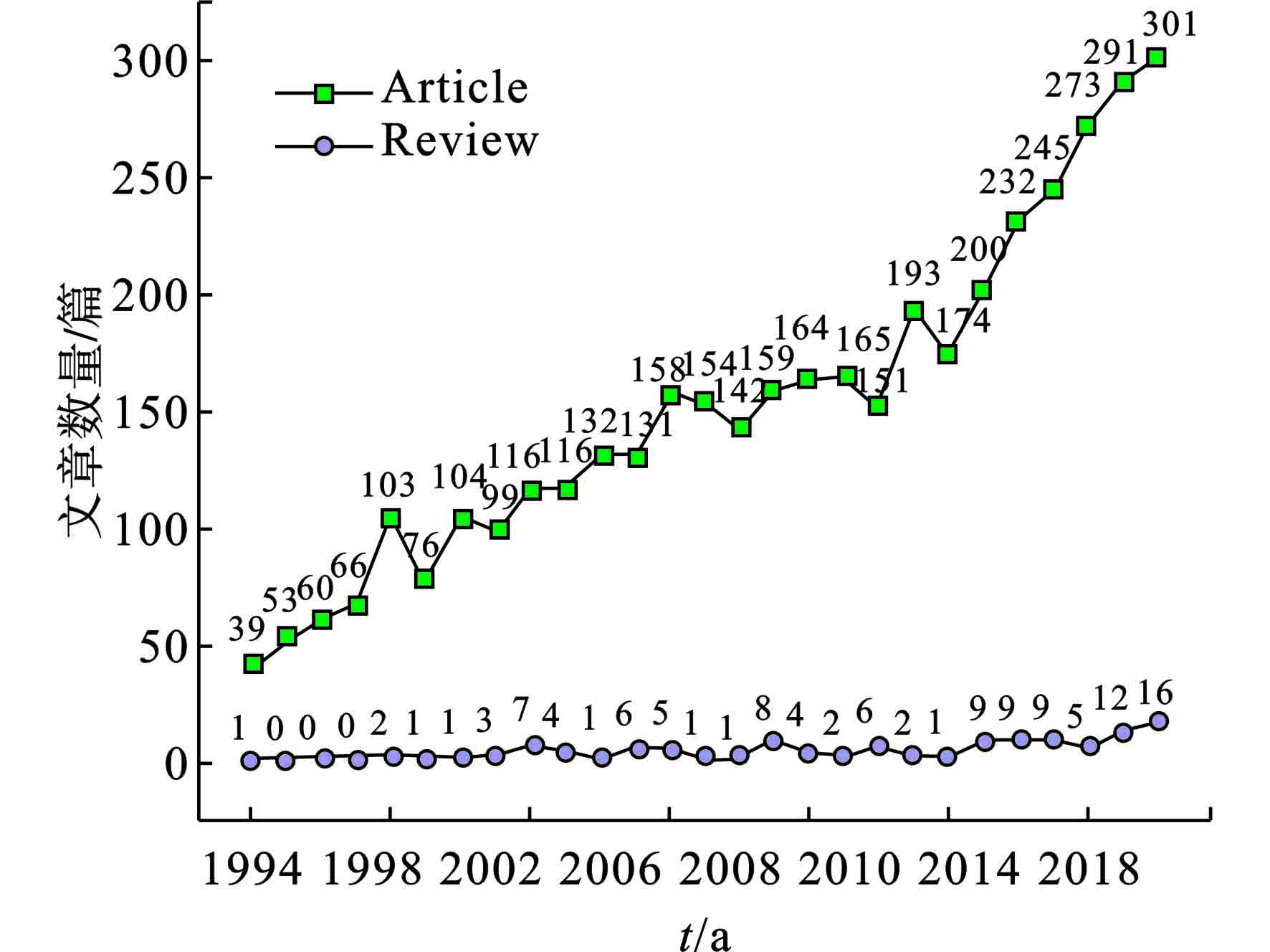
 下载:
下载:
